Ānuenue Fisheries Research Center
Location
 The Ānuenue Fisheries Research Center (AFRC) is a facility of the State of Hawai’i’s Division of Aquatic Resources, Department of Land and Natural Resources. It is situated on a 4.25-acre parcel on Sand Island, some six miles from downtown Honolulu.
The Ānuenue Fisheries Research Center (AFRC) is a facility of the State of Hawai’i’s Division of Aquatic Resources, Department of Land and Natural Resources. It is situated on a 4.25-acre parcel on Sand Island, some six miles from downtown Honolulu.
Facilities
The AFRC serves as a base yard, hatchery, and culture center for the Division of Aquatic Resources. The physical facilities include: (1) an office complex; (2) a 7,000 square feet complex that houses a biological-chemical laboratory, freshwater fish hatchery, workshop and storage areas for fisheries survey gear, equipment, and boats; (3) a 19,000 square feet thermocontrolled hatchery building; (4) the Chief Biologist’s residence; and (5) quarantine facility for aquatic animal disease studies.
Other Infrastructure
Other infrastructure include a boat launching ramp, 12-inch saltwater well, two 5,000 gallon water towers (one to aerate the seawater, the other to mix with freshwater to desired salinity), assorted outdoor tanks, a 45 kVA emergency generator for power outages, and related support facilities.
Staffing
The AFRC’s full-time permanent staff consists of three Aquatic Biologists and six Fishery Technicians. In addition, the full-time temporary staff include three Fishery Technicians and a Librarian.
The AFRC staff also works closely with the Department of Agriculture’s Aquaculture Disease Program whose full-time staff includes an Aquaculture Disease Specialist, two microbiologists, and a field diagnostic-disease specialist.
Recreational-Sportfishing & Aquaculture Activities
The AFRC is involved in all aspects of our fisheries and aquaculture programs. Current activity involves the production of channel catfish and rainbow trout for stocking of public fishing areas at Nu’uanu (O’ahu) and Koke’e (Kaua’i), respectively. In addition, natural stock enhancement experiments are also being conducted with the release of mullet pua (baby fingerlings) into Hilo Bay and Kona areas on the island of Hawai’i, and the release of moi juveniles (moili’i) on O’ahu (in the Waikiki-Diamond Head Fisheries Management Area) and on Maui (in Wailua Bay and Honomanu Bay).
Culture experiments currently include the moi, kumu, ulua, aholehole, hybrid rose tilapia, Samoan crab, and ogo. Collaborative studies are being conducted on moi and opakapaka in cooperation with Hawaii Institute of Marine Biology and the Oceanic Institute. Cooperation, support, and infrastructure assistance are also provided to the University of Hawai’i’s Sea Grant Extension Program (UHSG), the Center for Tropical and Subtropical Aquaculture (CTSA), and Waikiki Aquarium, and the Hawaii Aquaculture Association.
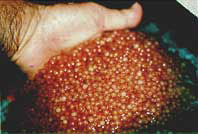
Channel catfish eggs
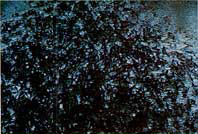
Channel catfish juveniles
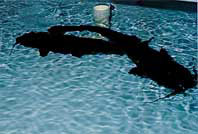
Channel catfish adults
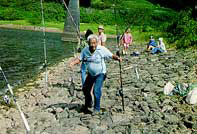
Fishing at Nu’uanu Reservoir
The recent success of the submerged offshore sea cage (moi experiment) and land based operations has resulted in an increase in the demand for moi seed stock. The AFRC is expanding its moi seed stock production to accommodate the needs of the growing moi aquaculture industry in Hawai’i.
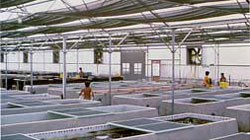
Interior of AFRC thermocontrolled facility

Moi in tank
The staff at the AFRC also provide extension service to Hawai’i’s aquaculture community, with services including pond chemistry, pond management, hatchery design, farm production management and marketing, and library research, etc. In addition, aquatic management and disease diagnostic services are available through the Aquaculture Development Program’s Disease Specialist stationed at the AFRC.
Fisheries Support
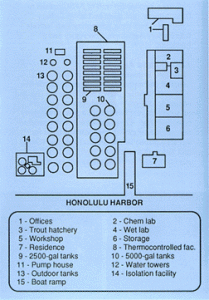
Diagram illustrating layout of the facilities at Anuenue Fisheries Research Center.
The AFRC supports all of the Division’s programs relating to freshwater and marine biological surveys, fish stock assessments, fish aggregating devices, artificial reefs, drift net removal, and fish kill and pollution investigations, as necessary. AFRC serves as a base yard for equipment, boats and vehicles. Field survey work is based out of the facility. The AFRC’s Fishery Technicians provide a pool of manpower responsible for boat and vehicle maintenance, and servicing/repairing of fisheries survey equipment and gear. The Fishery Technicians are certified divers, and participate in marine surveys with Aquatic Biologists using SCUBA and other survey related equipment.

AFRC Technicians and Division biologists conducting fish transects
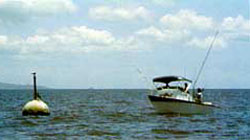
Fish Aggregating Device (FAD) constructed at AFRC and nearby Snug Harbor.
